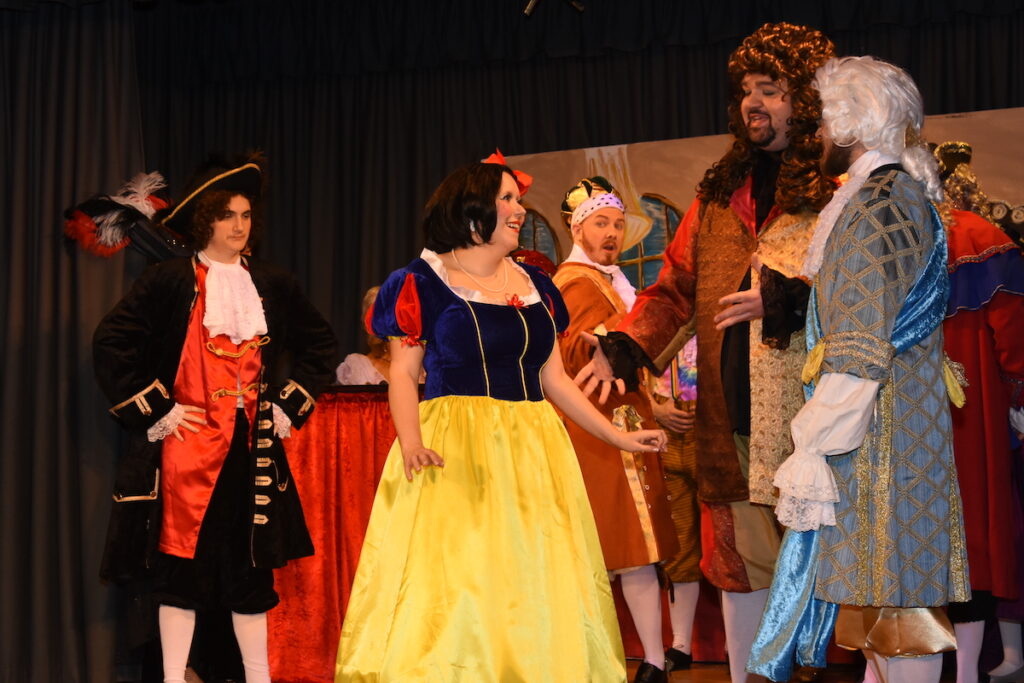By John Taylor | Photo, Laleham Players
It’s that time of year, when at theatres throughout the country we hear the sound of “He’s behind you”, “Oh yes it is” and “Oh no it isn’t”. A festive outing for all ages, a visit to a pantomime is great fun. It’s usually a child’s first theatre experience, with the ex-citement of their first ‘Panto’ being something they will always remember. The audience, the bright lights, watching the dancers, changes of scenery, hearing the band, and seeing the many different characters. I remember being taken to a pantomime at an early age, and my wife and I have taken our own children, and in recent years the grandchildren. We enjoy the experience as much as they do. One encyclopaedia describes this type of en-tertainment as ‘A Christmas play, loosely connected to a fairy-tale or nursery-rhyme which was developed in Victorian and Ed-wardian Britain’. From the Latin word Panto-mimus, Roman productions were based upon myth or legend, and music was supplied by a flautist. Performances might be in a private household or else a lavish theatrical produc-tion with a large orchestra. In 16th century Italy pantomime had its roots in ‘Commedia dell’arte,’ an entertainment which used dance, music, and a cast of mischievous actors, known as Harlequins. In the early 17th century they appeared in English comic plays, intro-duced by theatre impresario John Rich. This was an early form of pantomime. The stories involving magic, acrobats, and lovers. In the late 1700’s, the sets were made more elabo-rate, and by the Victorian era this form of show had become a popular custom at Christ-mas. With stories based on children’s tales such as Cinderella, Peter Pan, Aladdin, Sleep-ing Beauty, Jack and the Beanstalk, Dick Whittington, and Mother Goose. The Princi-pal Boy was, and continues to this day to be mostly played by a woman. Whilst the dame is usually played by a man in drag. During World War 11, Princess Elizabeth and Princess Margaret stared in a production of Aladdin at Windsor Castle. Elizabeth playing principal boy and Margaret as the Princess of China. Music Hall and Variety theatre have all played a part in the pantomime that we see today. Impresario Augustus Harris being mainly responsible for the modern lavish pro-ductions. The audience is encouraged to join in with singing, booing the villain, or cheering the hero, and sometimes children are invited on the stage to join in with the fun. Slapstick is often a part of any performance, as well as jokes about current news items. These shows are as popular as ever, still traditional, but now frequently including on stage, pop sing-ers, comedians, actors and presenters seen on television, and modern technology has made the sets even more amazing. Productions usu-ally begin in late November or early Decem-ber, and continue through into January, with two or three performances most days. After the Pandemic which last year restricted performances, there is now a full choice of pantomimes available this coming season. Whether in London or at a local theatre, or village hall, seeing both professional and am-ateur actors taking part. A Yuletide Holiday treat, not just for families but for anyone wanting a fun filled enjoyable afternoon or evening at the theatre. “Now, which Panto for this Christmas?”.

